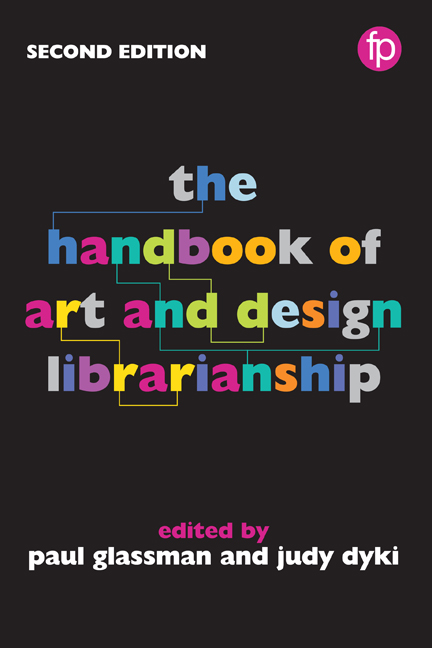Book contents
- Frontmatter
- Contents
- List of figures and tables
- Notes on contributors
- Foreword
- Preface
- Part I Roles and responsibilities
- Part II Materials and collection management
- Part III Teaching and learning
- 14 Embedded in their world: moving mentally into the studio environment
- 15 Teaching with threshold concepts and the ACRL Framework in the art and design context
- 16 Teaching by the book: art history pedagogy and special collections
- 17 Metaliteracy in art and design education: implications for library instruction
- 18 The art of evidence: a method for instructing students in art history research
- 19 ‘I want students to research the idea of red’: using instructional design for teaching information literacy in the fine arts
- 20 Cultural differences and information literacy competencies
- Part IV Knowledge creation
- Part V The physical environment
- Part VI Promotion and sustainability
- Appendix Library profiles
- Index
20 - Cultural differences and information literacy competencies
from Part III - Teaching and learning
Published online by Cambridge University Press: 08 June 2018
- Frontmatter
- Contents
- List of figures and tables
- Notes on contributors
- Foreword
- Preface
- Part I Roles and responsibilities
- Part II Materials and collection management
- Part III Teaching and learning
- 14 Embedded in their world: moving mentally into the studio environment
- 15 Teaching with threshold concepts and the ACRL Framework in the art and design context
- 16 Teaching by the book: art history pedagogy and special collections
- 17 Metaliteracy in art and design education: implications for library instruction
- 18 The art of evidence: a method for instructing students in art history research
- 19 ‘I want students to research the idea of red’: using instructional design for teaching information literacy in the fine arts
- 20 Cultural differences and information literacy competencies
- Part IV Knowledge creation
- Part V The physical environment
- Part VI Promotion and sustainability
- Appendix Library profiles
- Index
Summary
Design students can pose multiple challenges for librarians. Their information-seeking behaviours are often less linear than those of their university colleagues. Developing library initiatives and instruction becomes even more challenging when working with international students who bring different cultural backgrounds and language competencies to their college programme. They also have varying degrees of experience with and knowledge about libraries. These obvious barriers, in addition to more subtle obstacles such as cultural background and academic history, all affect their expectations and use of a library (Curry and Copeman, 2005, 410). Librarians working with English as a Foreign Language (EFL) design students need to address both the informationseeking behaviours of design students while also being aware of the unique needs of an international student population.
A diverse student body
According to the Institute of International Education's Open Doors Report on International Educational Exchange (IIE, 2016b), there were over 1 million international students studying in the USA in the 2015/16 academic year, an increase of 2.4% from the previous year. Of these students, approximately 60,000 studied fine and applied arts, a 5.2% increase from the previous year. Chinese students made up almost a third of the total with an increase of 8.1% from the previous year. Other top countries sending students to the USA are India, Saudi Arabia and South Korea (IIE, 2016b). With such diversity, librarians need to be aware of the cultural differences of their student body, specifically in how they affect their information-seeking behaviours.
Many institutions have developed gateway programmes for international students, which offer language support and help with cultural adjustment along with academic courses, and they serve as a pathway into a degree programme. These initiatives fulfil two purposes. International students bring diverse backgrounds and social values to their academic experience and can contribute to the university's diversity initiatives. At the same time, international students are an important source of revenue because they pay full tuition fees, or out-of-state tuition fees for public institutions.
- Type
- Chapter
- Information
- The Handbook of Art and Design Librarianship , pp. 203 - 210Publisher: FacetPrint publication year: 2017



